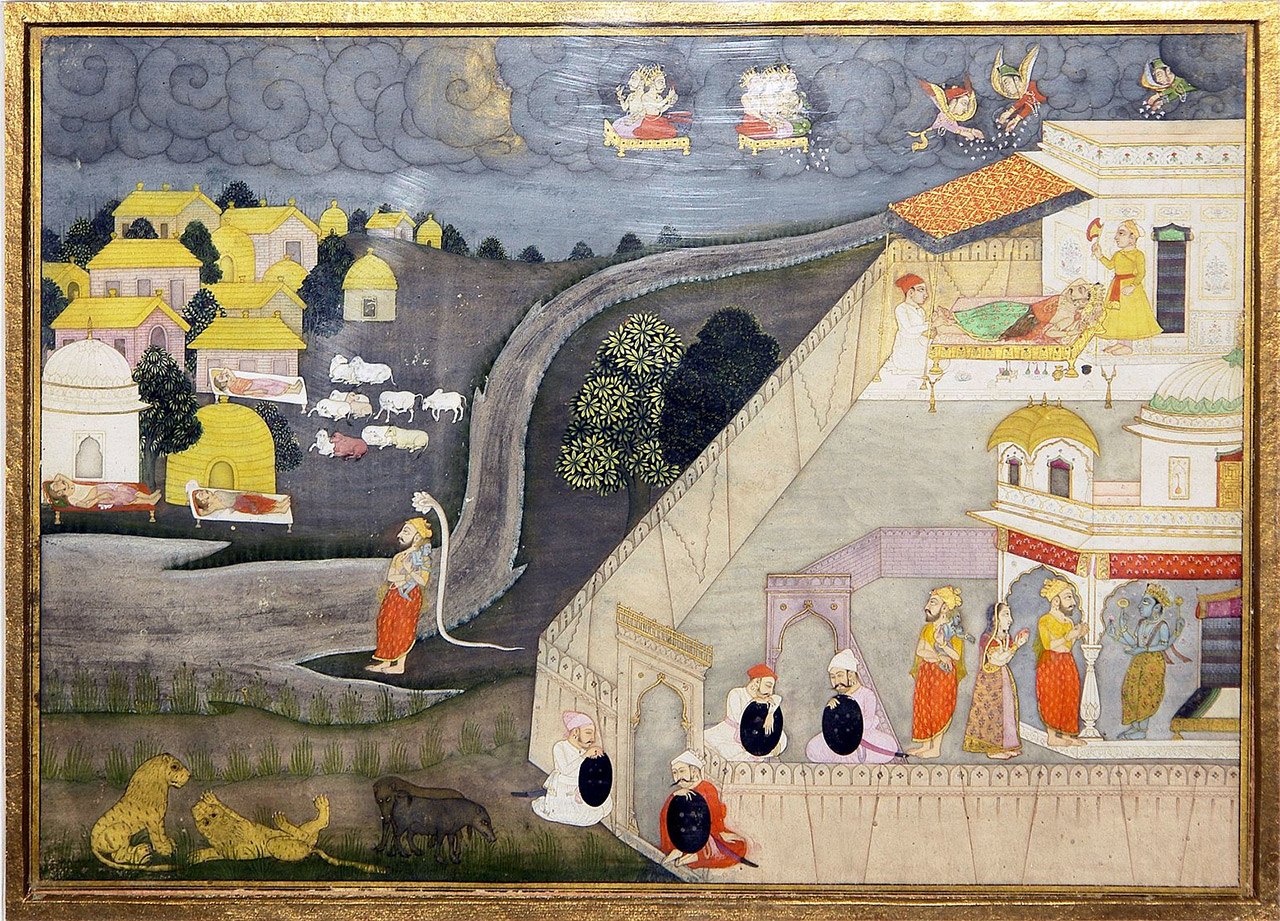
Created with finesse with delicate strokes of the brush and bold use of colours, the tradition of miniature painting in India began with palm leaves for canvas. It was done on smooth surfaces with exquisite natural colours and delicate brushstrokes. Under the reign of the Mughals, this form of painting fledged to its potential, along with various other art forms of India. Today, we trace the different types of style and influence that the miniature paintings of India went through throughout history, since its origin.
Pala School of Miniature Painting

The Pala school traces its origin back into the 7th century AD when it grew under the patronage of the Palas of Bengal. The themes and stories that it portrayed were primarily inspired by Buddhist texts and scriptures. The symbolic and subtle use of colours, graceful strokes of lines, and delicate forms of figures was emphasized upon. The intricate concepts and styles of the Pala school were taught at the Buddhist monasteries of Nalanda, Somapura Mahavihara, Odantapuri and Vikramasila.
Jaina School of Miniature Painting

Jainism influenced the rise of miniature paintings in western India from the 12th to the 16th century AD. The Jaina paintings depicted stories from religious texts like ‘Kalpa Sutra’ and ‘Kalkacharya Katha’ and prevailed in regions of Malwa, Rajasthan and Gujarat. Some of the characteristic features of these paintings include enlarged eyes and square-shaped hands. Organic colours, including the paint derived from the dust of stones and metals like gold and silver, were used for painting. The stories that were depicted were inspired by Jain religious texts, like the figures of Tirthankara goddess and Gandhara Sudharma. Primarily using red, green, yellow and blue colours, the subjects in the paintings were ornamented heavily.
Mughal School of Miniature Painting

The fine and intricate depiction of the Mughal School of miniature painting was a blend of both Indian and Persian styles. These paintings flourished from the 16th to the 18 centuries AD and were based on naturalistic observation of contemporary life, also influenced by religion and traditions. Thus, they documented scenes of the royal court, hunting expeditions, wildlife and nature as well as battlefields. Every inch of detail was entrusted with rich ornamentations and delicate strokes. Often, many manuscripts were chosen to be illustrated in the paintings and scenes of ascetics and mystics were also depicted. Throughout the reign of the Mughals, there was a different emphasis on the subject of portrayal. Under Akbar’s reign, royal achievements and courtly scenes were significant. While Humayun and Jahangir chose scenes from their own lives to be depicted, artists during Shah Jahan’s time gave importance to portraiture. Bichiter, Anup Chattar, Chaitaraman, and Inayat were some of the most renowned artists during this age. The practice of art began its decline during Aurangzeb’s time because of the emperor’s staunch religious beliefs that Islam prohibits the practice of art.
Rajasthan School of Miniature Painting

With the Mughal form declining, the Rajasthani schools began to rise as the artists sought for different patronage. The Rajput style of miniature painting centred around the epic works of Ramayana and Mahabharata and also depicted the mythical love stories of Lord Krishna. Its most distinct schools include the ones established at Malwa, Mewar, Hadoti, Marwar and Amber. Despite the variance in style from one region to another, the artists had the common ground of life in the Rajput Kingdom to base their paintings on. Exaggerated features like elongated eyes, fingers and necks served as a distinct characteristic feature of these paintings. Fine brushes were used to colour the paintings in contrasting details and the paints were extracted from plants, minerals, shells and even metals like gold and silver. Today, this painstaking form of art is practised on paper, ivory or silk canvas using manufactured synthetic colours.
Orissa School of Miniature Painting

Depicting mythical stories from ‘Krishna Leela’ and ‘Gita Govinda’, the Orissa school of miniature painting came to significance during the 17th century AD. With bold strokes of the colour, the artists expressed the beautiful landscapes of eastern India in rich detail. The contrasting colours gave a majestic appeal to art.
Pahari School of Miniature Painting

Developed from both the Mughal miniature art and Vaishnavite stories, the Pahari school flourished in the northwestern region of India. The Pahari school of miniature painting has its further division into various sub-schools. The bold Basohli art with its use of monochrome colours and multi-floor structures, the delicate Kangra style with its lyrical portrayal of naturalism and ‘sringar’ or adorning. To name a few others would be the Guler and the Kullu-Mandi schools. With bold colours and ornamented frames, the paintings usually depict deities, mythological scenes, and the subjects were often portrayed against the backdrop of the magnificent beauty of the Himalayan mountains.
Deccan School of Miniature Painting

The Deccan school incorporated elements from the Iranian, Turkish, Arabian and South Indian schools of miniature paintings. It had spread its stronghold in the regions of Ahmednagar, Tanjore, Golconda, Hyderabad and Bijapur from the 16th to 19th century A.D. With intense colours and sensual figures, the Deccan school emphasized the practice of symmetrical arrangements of the subjects. The paintings were derived from the text of the Holy Quran and the Surahs. Later on during this era, indigenous art forms, romantic elements and Mughal styles were assimilated into the art form.
The scenes and subjects depicted in the miniature paintings of India unravel stories through their intricate details. Although the practice of these paintings during modern times is not as exceptional as the original tradition, the importance of the art form lies in its role as a chronicler of historical times. Museums and forts today house these inimitable works of art.







